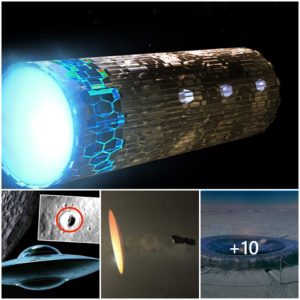Chen, a postdoctoral in National Astronomical Observatory of China, and her team scanned part of the Northern Sky to search for these hyper-advanced aliens. Out of 21 galaxies, two outliers are so far unidentified. While it’s a long shot, those two may be precisely what Chen is looking for.
WHAT’S A KARDASHEV TYPE III CIVILIZATION?

Across the vast universe, the possibility of life forms varies dramatically from primitive bacteria-like microbes to hyper-advanced alien civilizations.
The Kardashev scale, developed by astrophysicist Nikolai Kardashev in 1964, measures how far technologically advanced a hypothetical alien civilization is based on the amount of energy it consumes.
The scale has three types of civilizations:
Type II civilization, one that consumes as much power at the scale of its entire star system (meaning its host star and the other planets that orbit it)Type III civilization, the most advanced kind which can harness as much energy as the entire galaxyAs of now, human civilization has not even achieved full Type I status. Instead, we’re at a measly 0.73 since we are still not able to harness all of the solar energy that reaches Earth. Scientists predict that it would take us 100 to 200 years to reach Type I.
On the other hand, a Type III civilization is way past us.
This civilization may employ its galaxy’s stars to harness energy using the hypothetical structure called a Dyson sphere. These theoretical megastructures surround a star to collect its energy output. By harnessing the power of its star through a space-based system, an alien civilization could meet its growing energy requirements to push its society to the next level.
A Type III civilization would have likely put Dyson spheres on more than just its host star, but on surrounding ones as well.

For the study, the researchers looked at the emissions of 21 galaxies with high mid-infrared emissions. Four of these galaxies had mid-infrared emissions enhanced by a factor of 10.
“Two of them were identified as natural sources — one was an active galactic nuclei, and another was a star-forming galaxy, which means their excessive mid-infrared emissions arise from different kinds of mechanisms,” Chen says. “We don’t know the reason for the high mid-infrared-to-radio ratio of the other two.”

Chen explains that there is a correlation between the radio and infrared emissions of every galaxy. Galaxies emit radiation across the infrared spectrum, which gives off information about the heat. The duo looked in the mid- and far-infrared spectrum on the hunt for what amounts to alien exhaust.
“The mid-infrared emission of a Type III civilization would be excessive due to waste heat in the mid-infrared, making it bias from the correlation,” Chen says.
Two galaxies remained unidentified, and possible hosts of a Type III civilization. Meaning that the scientists could not figure out what is causing their spike in mid-infrared emissions, but it is still not clear whether it is due to an unusually high star formation rate or an exceptionally bright galactic center.
In the paper, Chen and Garrett mark that the two galaxies, ILT J134649.72+542621.7 and ILT J145757.90+565323.8, “warrant further investigation.”

In order to determine whether or not these two galaxies have a hyper advanced alien civilization, the researchers need to determine the source of their mid-infrared emissions.
“We can look at their emissions in other wavelengths such as X-ray, optical, and see if their spectral energy distribution is active galactic nuclei-like or star-forming-galaxy-like,” Chen says. “We can also have high-resolution radio observations on them to look at their morphology.”
The researchers are also planning on expanding their search for alien civilizations to a broader region of the cosmos to cover the full Northern Sky.
Abstract: Kardashev Type III civilisations have by definition energy requirements that are likely to generate strong excess emission in the mid-infrared (MIR) that is associated with the waste heat they generate. For those civilisations that capture starlight via Dyson sphere like constructions, the Optical to MIR flux ratio of the host galaxies is also expected to be unusually low.
Since a wide range of galaxy types adhere to the infrared-radio correlation (IRC), galaxies hosting Type III civilisations should also strongly deviate from this relation. Radio data can therefore play a crucial role in breaking the degeneracy between the effects of dust obscuration in a galaxy and the signature of an energy-intensive civilisation.

We have used the newly released LoTSS-DR1 value-added catalogue to create a sample of 16 367 z < 0.2 sources with radio and MIR flux densities, optical photometry and (photometric) redshifts. We calculated the IRC parameter q22 μm150 MHz = log(S150 MHz/ S22 μm ) and identified 21 sources with exceptionally high values of q22 μm150 MHz , an indication of MIR emission enhanced by a factor of ~10.
Out of the 21 high q-value sources, 4 sources have very red MIR colours, and appear to have relatively low optical/MIR ratios. Two of the four sources are not well known in the literature, they are considered as potential hosts of Type III civilisations. These sources deserve further study and investigation.
Finally, we note that extending our analysis to the full LoTSS survey area can place very strong constraints on the incidence of Type III civilisations in the Universe.





